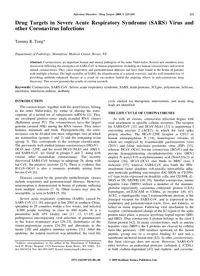
2009 Drug Targets in Severe Acute Respiratory Syndrome (SARS) Virus and other Coronavirus Infections PDF
Preview 2009 Drug Targets in Severe Acute Respiratory Syndrome (SARS) Virus and other Coronavirus Infections
Infectious Disorders - Drug Targets 2009, 9, 223-245 223 1871-5265/09 $55.00+.00 © 2009 Bentham Science Publishers Ltd. Drug Targets in Severe Acute Respiratory Syndrome (SARS) Virus and other Coronavirus Infections Tommy R. Tong* Department of Pathology, Montefiore Medical Center, Bronx, NY Abstract: Coronaviruses are important human and animal pathogens of the order Nidovirales. Several new members were discovered following the emergence of SARS-CoV in human populations, including two human coronaviruses and several animal coronaviruses. They cause respiratory and gastrointestinal illnesses and have been found in the brains of patients with multiple sclerosis. The high mortality of SARS, the identification of a natural reservoir, and the well-founded fear of provoking antibody-enhanced disease as a result of vaccination fueled the ongoing efforts in anti-coronavirus drug discovery. This review presents the results of current research. Keywords: Coronavirus, SARS-CoV, Severe acute respiratory syndrome, SARS, main protease, 3CLpro, polymerase, helicase, interferon, interferon-inducer, antibody INTRODUCTION The coronaviruses, together with the arteriviruses, belong to the order Nidovirales, by virtue of sharing the trans- criptome of a nested set of subgenomic mRNAs [1]. They are enveloped positive-sense single-stranded RNA viruses (Baltimore group IV). The coronaviruses have the largest genome (around 30K) among the RNA viruses. They infect humans, mammals and birds. Phylogenetically, the coro- naviruses can be divided into three subgroups, two of which are mammalian (groups 1 and 2) and the remaining avian (group 3). This corresponds to the serotype classification. The previously well-studied human coronaviruses (HCoV), - OC43 and -229E, and the novel HCoV-NL63 and -HKU1, and SARS-CoV, are found in groups 1 and 2, along with various other mammalian coronaviruses. The recently discovered SARS-CoV belongs to subgroup 2b, along with bat-CoV, the putative ancestor [2-5], There is evidence that H-CoV-OC43 is also a zoonosis, probably arising from bovine CoV [6]. Diseases caused by the generally epitheliotropic viruses include respiratory and gastrointestinal illnesses. However, neurotropism is demonstrated in brains of patients suffering from multiple sclerosis [7, 8]. Other tissues may also be susceptible, as seen in SARS [9, 10]. Severe acute respiratory syndrome (SARS), caused by SARS-CoV [11-16], emerged in late 2002 in southern China, spreading to 29 countries within a few weeks, and infected ~8,000 people resulting in close to 800 deaths. It is a pneumonia with 10% fatality rate [11, 12, 17-19] and pathogenesis encompassing viral infection of pneumocytes in the lower respiratory tract [20-23], disturbance of the rennin-angiotensin system [24-29] and alterations in the innate [30] and adaptive immune systems [31]. After the epidemic, the natural reservoir was identified, the viral life *Address correspondence to this author at the Department of Pathology, Jack D. Weiler Hospital, 1825 Eastchester Road, Bronx, NY 10461; Tel: 661-889-8218; Fax: 661-885-5297; E-mail:
